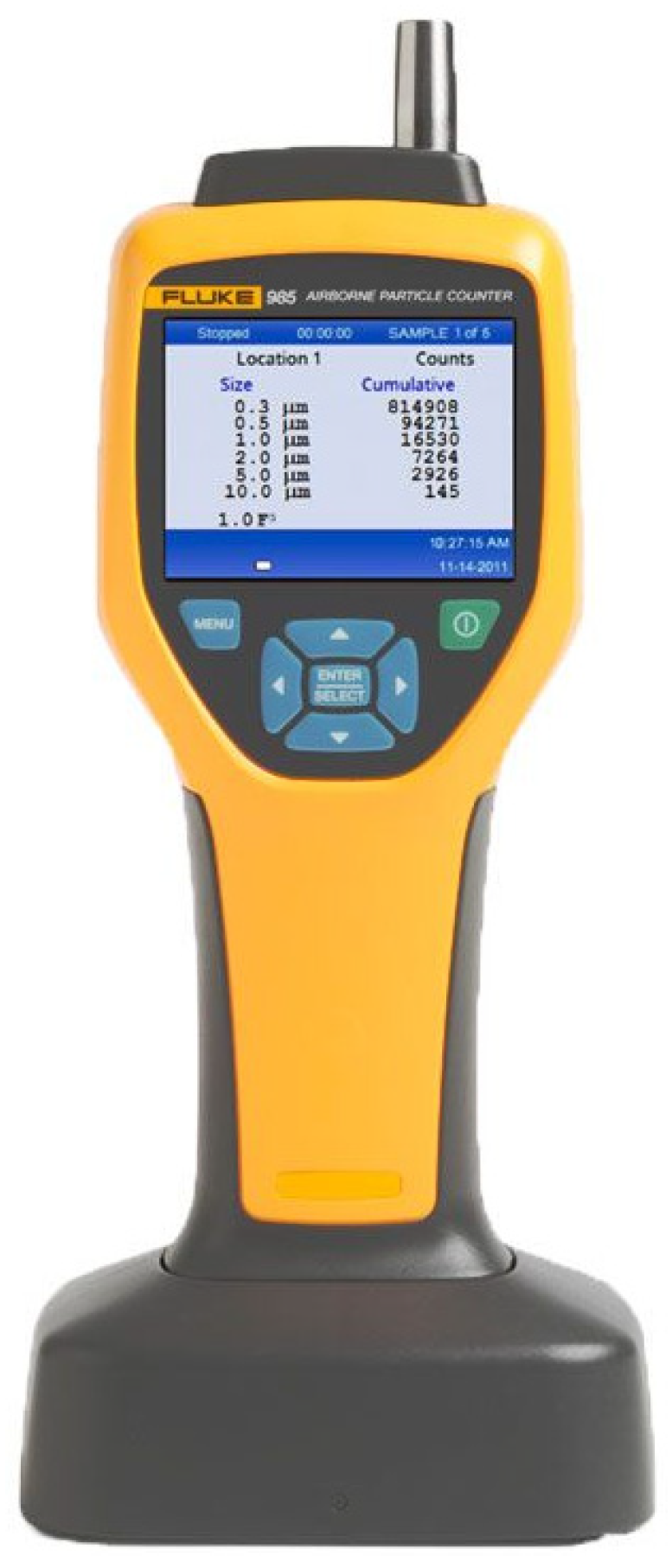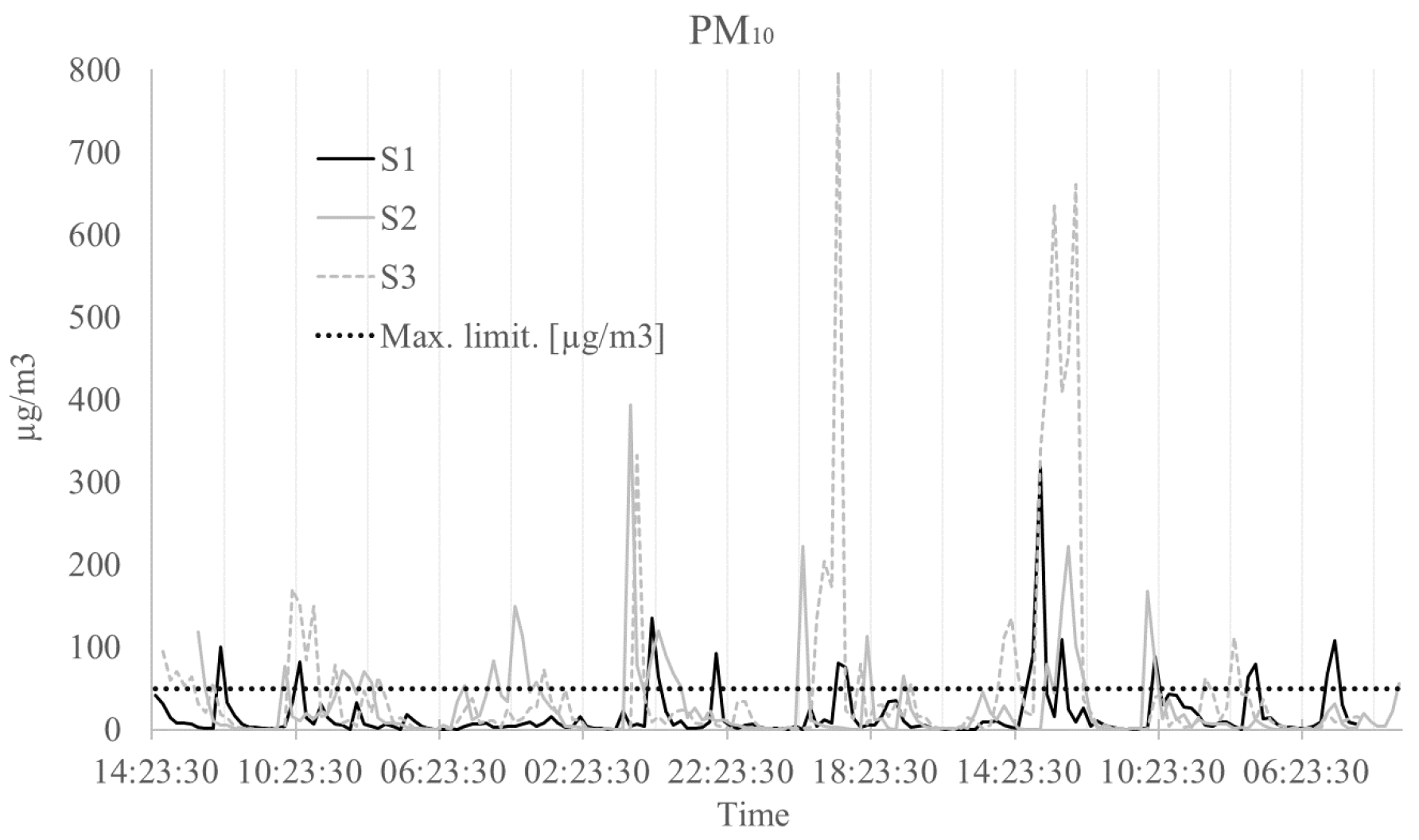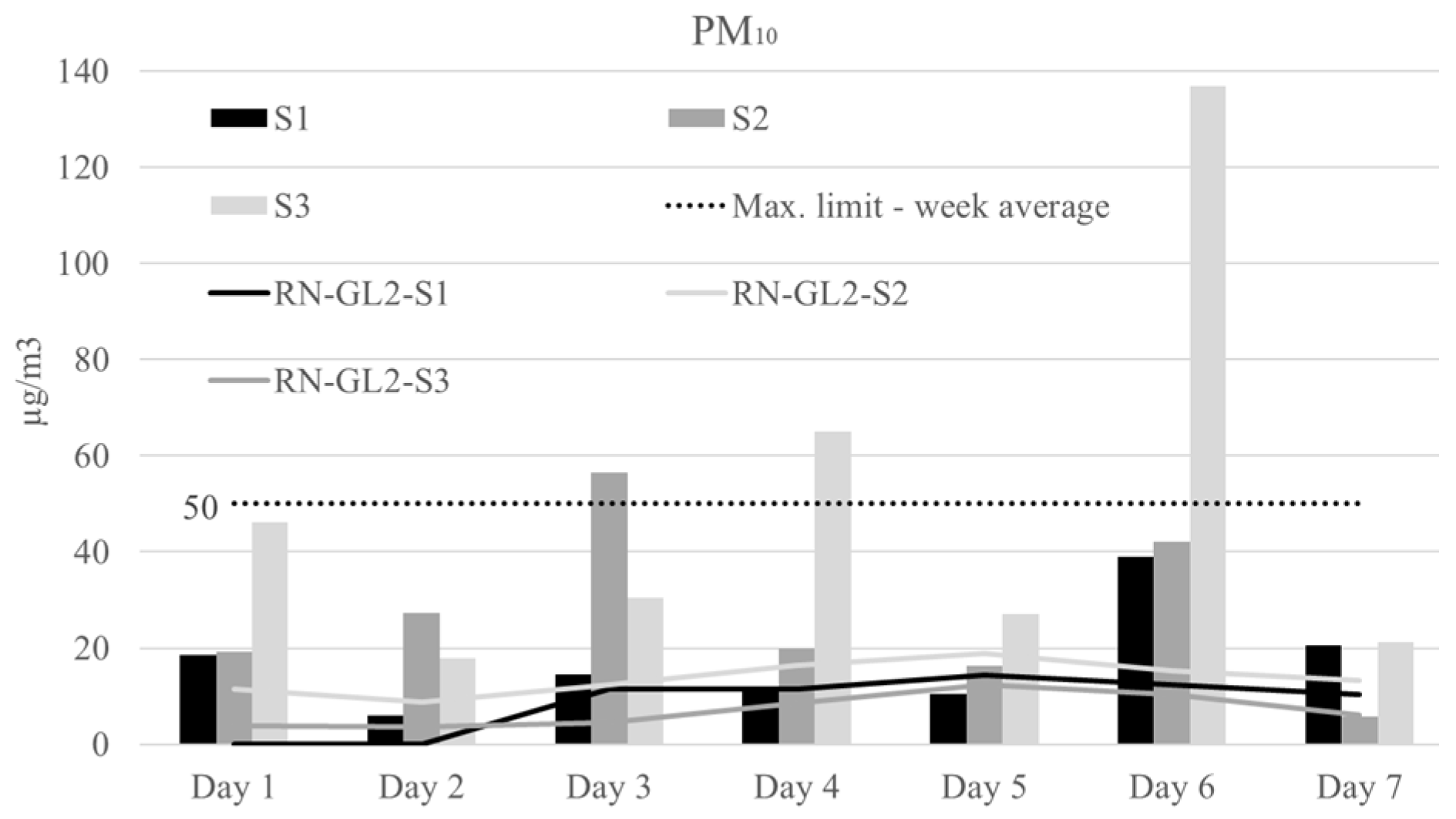A Study on Indoor Particulate Matter Variation in Time Based on Count and Sizes and in Relation to Meteorological Conditions
Abstract
:1. Introduction
2. Materials and Methods
3. Results and Discussion
4. Conclusions
Funding
Institutional Review Board Statement
Informed Consent Statement
Data Availability Statement
Conflicts of Interest
References
- Directive 2008/50/EC of the European Parliament and of the Council of 21 May 2008 on Ambient Air Quality and Cleaner Air for Europe. 2008. Available online: https://eur-lex.europa.eu/legal-content/en/ALL/?uri=CELEX%3A32008L0050 (accessed on 5 July 2021).
- Normativ 02/07/2007, Portal Legislativ, Monitorul Oficial. 2007. Available online: http://legislatie.just.ro/Public/DetaliiDocumentAfis/83993 (accessed on 5 July 2021).
- Lelieveld, J.; Evans, J.S.; Fnais, M.; Giannadaki, D.; Pozzer, A. The contribution of outdoor air pollution sources to premature mortality on a global scale. Nat. Cell Biol. 2015, 525, 367–371. [Google Scholar] [CrossRef]
- Dockery, D.W.; Pope, C.A. Acute Respiratory Effects of Particulate Air Pollution. Annu. Rev. Public Health 1994, 15, 107–132. [Google Scholar] [CrossRef]
- Arangio, A.; Tong, H.; Socorro, J.; Pöschl, U.; Shiraiwa, M. Quantification of environmentally persistent free radicals and reactive oxygen species in atmospheric aerosol particles. Atmos. Chem. Phys. Discuss. 2016, 16, 13105–13119. [Google Scholar] [CrossRef] [Green Version]
- Shiraiwa, M.; Selzle, K.; Pöschl, U. Hazardous components and health effects of atmospheric aerosol particles: Reactive oxygen species, soot, polycyclic aromatic compounds and allergenic proteins. Free Radic. Res. 2012, 46, 927–939. [Google Scholar] [CrossRef]
- Alpert, P.A.; Dou, J.; Arroyo, P.C.; Schneider, F.; Xto, J.; Luo, B.; Peter, T.; Huthwelker, T.; Borca, C.N.; Henzler, K.D.; et al. Photolytic radical persistence due to anoxia in viscous aerosol particles. Nat. Commun. 2021, 12, 1769. [Google Scholar] [CrossRef]
- Yang, Q.; Yuan, Q.; Li, T.; Shen, H.; Zhang, L. The Relationships between PM2.5 and Meteorological Factors in China: Seasonal and Regional Variations. Int. J. Environ. Res. Public Health 2017, 14, 1510. [Google Scholar] [CrossRef] [Green Version]
- Paraschiv, S. Effects of wind speed, relative humidity, temperature and air pressure on PM10 concentration for an urban background area. IOP Conf. Ser. Mater. Sci. Eng. 2019, 595, 012059. [Google Scholar] [CrossRef]
- Jodeh, S.; Hasan, A.R.; Amarah, J.; Judeh, F.; Salghi, R.; Lgaz, H.; Jodeh, W. Indoor and outdoor air quality analysis for the city of Nablus in Palestine: Seasonal trends of PM10, PM5.0, PM2.5, and PM1.0 of residential homes. Air Qual. Atmos. Health 2017, 11, 229–237. [Google Scholar] [CrossRef]
- Rogulski, M. Indoor PM10 concentration measurements using low-cost monitors in selected locations in Warsaw. Energy Procedia 2018, 147, 137–144. [Google Scholar] [CrossRef]
- Pallarés, S.; Gómez, E.; Martínez, A.; Jordán, M.M. The relationship between indoor and outdoor levels of PM10 and its chemical composition at schools in a coastal region in Spain. Heliyon 2019, 5, e02270. [Google Scholar] [CrossRef] [Green Version]
- Nishihama, Y.; Jung, C.-R.; Nakayama, S.F.; Tamura, K.; Isobe, T.; Michikawa, T.; Iwai-Shimada, M.; Kobayashi, Y.; Sekiyama, M.; Taniguchi, Y.; et al. Indoor air quality of 5,000 households and its determinants. Part A: Particulate matter (PM2.5 and PM10–2.5) concentrations in the Japan Environment and Children’s Study. Environ. Res. 2021, 198, 111196. [Google Scholar] [CrossRef] [PubMed]
- Yoda, Y.; Tamura, K.; Shima, M. Airborne endotoxin concentrations in indoor and outdoor particulate matter and their predictors in an urban city. Indoor Air 2017, 27, 955–964. [Google Scholar] [CrossRef] [Green Version]
- Argunhan, Z.; Avci, A.S. Statistical Evaluation of Indoor Air Quality Parameters in Classrooms of a University. Adv. Meteorol. 2018, 2018, 4391579. [Google Scholar] [CrossRef]
- Liu, Y.; Zhou, B.; Wang, J.; Zhao, B. Health benefits and cost of using air purifiers to reduce exposure to ambient fine particulate pollution in China. J. Hazard. Mater. 2021, 414, 125540. [Google Scholar] [CrossRef]
- Fermo, P.; Artíñano, B.; De Gennaro, G.; Pantaleo, A.M.; Parente, A.; Battaglia, F.; Colicino, E.; Di Tanna, G.; Junior, A.G.D.S.; Pereira, I.G.; et al. Improving indoor air quality through an air purifier able to reduce aerosol particulate matter (PM) and volatile organic compounds (VOCs): Experimental results. Environ. Res. 2021, 197, 111131. [Google Scholar] [CrossRef]
- Kim, M.Y.; Jung, Y.G.; Park, J.C.; Yang, Y.K. The impact of airflow and air purification on the resuspension and removal of deposited particulate matter. J. Build. Eng. 2021, 41, 102367. [Google Scholar] [CrossRef]
- Penza, M.; Suriano, D.; Villani, M.G.; Spinelle, L.; Gerboles, M. Towards air quality indices in smart cities by calibrated low-cost sensors applied to networks. IEEE 2014, 2012–2017. [Google Scholar] [CrossRef]
- Castell, N.; Kobernus, M.; Liu, H.-Y.; Schneider, P.; Lahoz, W.; Berre, A.J.; Noll, J. Mobile technologies and services for environmental monitoring: The Citi-Sense-MOB approach. Urban. Clim. 2015, 14, 370–382. [Google Scholar] [CrossRef]
- Gulia, S.; Prasad, P.; Goyal, S.; Kumar, R. Sensor-based Wireless Air Quality Monitoring Network (SWAQMN)—A smart tool for urban air quality management. Atmos. Pollut. Res. 2020, 11, 1588–1597. [Google Scholar] [CrossRef]
- Lu, Y.; Giuliano, G.; Habre, R. Estimating hourly PM2.5 concentrations at the neighborhood scale using a low-cost air sensor network: A Los Angeles case study. Environ. Res. 2021, 195, 110653. [Google Scholar] [CrossRef]
- Global PM10 Map. Available online: https://www.uradmonitor.com/ (accessed on 30 May 2021).
- World’s Air Pollution: Real-Time Air Quality Index. Available online: https://waqi.info/ (accessed on 5 July 2021).
- Bodor, M.; de Jos, D. Indoor Concentration and Composition of Fine Particulate Matter (PM2.5) Near an Intense Circulated Road in an Industrial City. Ann. Dunarea Jos Univ. Galati. Fascicle IX Met. Mater. Sci. 2020, 43, 5–10. [Google Scholar] [CrossRef]
- Fluke 985 Particle Counter. Available online: https://test4less.co.uk/fluke-985-particle-counter.html (accessed on 2 April 2021).
- Available online: https://www.calitateaer.ro/public/monitoring-page/reports-reports-page/?__locale=en (accessed on 7 April 2021).
- Dust Collection Research–Dylos. Available online: https://billpentz.com/woodworking/cyclone/dylos.php (accessed on 14 May 2021).
- Lu, X.; Sha, Y.H.; Li, Z.; Huang, Y.; Chen, W.; Chen, D.; Shen, J.; Chen, Y.; Fung, J.C. Development and application of a hybrid long-short term memory–three dimensional variational technique for the improvement of PM2.5 forecasting. Sci. Total Environ. 2021, 770, 144221. [Google Scholar] [CrossRef] [PubMed]
- Luo, J.; Du, P.; Samat, A.; Xia, J.; Che, M.; Xue, Z. Spatiotemporal Pattern of PM2.5 Concentrations in Mainland China and Analysis of Its Influencing Factors using Geographically Weighted Regression. Sci. Rep. 2017, 7, 40607. [Google Scholar] [CrossRef] [PubMed]
- Chen, T.; He, J.; Lu, X.; She, J.; Guan, Z. Spatial and Temporal Variations of PM2.5 and Its Relation to Meteorological Factors in the Urban Area of Nanjing, China. Int. J. Environ. Res. Public Health 2016, 13, 921. [Google Scholar] [CrossRef] [PubMed]
- Li, J.J.; Wang, G.H.; Wang, X.; Cao, J.J.; Sun, T.; Cheng, C.L.; Meng, J.J.; Hu, T.F.; Liu, S.X. Abundance, composition and source of atmospheric PM2.5 at a remote site in the Tibetan Plateau, China. Tellus B Chem. Phys. Meteorol. 2013, 65. [Google Scholar] [CrossRef]
- Chen, Z.; Cai, J.; Gao, B.; Xu, B.; Dai, S.; He, B.; Xie, X. Detecting the causality influence of individual meteorological factors on local PM2.5 concentration in the Jing-Jin-Ji region. Sci. Rep. 2017, 7, 40735. [Google Scholar] [CrossRef] [Green Version]
- Zhang, H.; Wang, Y.; Hu, J.; Ying, Q.; Hu, X.-M. Relationships between meteorological parameters and criteria air pollutants in three megacities in China. Environ. Res. 2015, 140, 242–254. [Google Scholar] [CrossRef]
- Wang, Y.; Ying, Q.; Hu, J.; Zhang, H. Spatial and temporal variations of six criteria air pollutants in 31 provincial capital cities in China during 2013–2014. Environ. Int. 2014, 73, 413–422. [Google Scholar] [CrossRef]
- Daly, C.; Gibson, W.; Taylor, G.; Johnson, G.; Pasteris, P. A knowledge-based approach to the statistical mapping of climate. Clim. Res. 2002, 22, 99–113. [Google Scholar] [CrossRef] [Green Version]
- LEGE 104 15/06/2011-Portal Legislativ. Available online: http://legislatie.just.ro/Public/DetaliiDocument/129642 (accessed on 28 May 2021).
- Bodor, M.; Baltă, Ș; Pintilie, Ș.C.; Lazăr, A.L.; Buruiană, D. Studies regarding the distribution and composition of particulate matters in the air of an industrialized city. SGEM 2016, 2, 587–591. [Google Scholar] [CrossRef]
- Pan, S.; Du, S.; Wang, X.; Zhang, X.; Xia, L.; Liu, J.; Pei, F.; Wei, Y. Analysis and interpretation of the particulate matter (PM10 and PM2.5) concentrations at the subway stations in Beijing, China. Sustain. Cities Soc. 2019, 45, 366–377. [Google Scholar] [CrossRef]
- Stranger, M.; Potgieter-Vermaak, S.; Van Grieken, R. Comparative overview of indoor air quality in Antwerp, Belgium. Environ. Int. 2007, 33, 789–797. [Google Scholar] [CrossRef] [PubMed]
- Jeong, C.-H.; Salehi, S.; Wu, J.; North, M.L.; Kim, J.S.; Chow, C.-W.; Evans, G.J. Indoor measurements of air pollutants in residential houses in urban and suburban areas: Indoor versus ambient concentrations. Sci. Total Environ. 2019, 693, 133446. [Google Scholar] [CrossRef] [PubMed]
- Portable Particulate Monitor-Measure PM2.5/PM10. Available online: https://www.aeroqual.com/product/portable-particulate-monitor (accessed on 30 May 2021).
- Air Quality Meter|PCE Instruments. Available online: https://www.pce-instruments.com/english/measuring-instruments/test-meters/air-quality-meter-kat_150925.htm (accessed on 30 May 2021).





Publisher’s Note: MDPI stays neutral with regard to jurisdictional claims in published maps and institutional affiliations. |
© 2021 by the author. Licensee MDPI, Basel, Switzerland. This article is an open access article distributed under the terms and conditions of the Creative Commons Attribution (CC BY) license (https://creativecommons.org/licenses/by/4.0/).
Share and Cite
Bodor, M. A Study on Indoor Particulate Matter Variation in Time Based on Count and Sizes and in Relation to Meteorological Conditions. Sustainability 2021, 13, 8263. https://doi.org/10.3390/su13158263
Bodor M. A Study on Indoor Particulate Matter Variation in Time Based on Count and Sizes and in Relation to Meteorological Conditions. Sustainability. 2021; 13(15):8263. https://doi.org/10.3390/su13158263
Chicago/Turabian StyleBodor, Marius. 2021. "A Study on Indoor Particulate Matter Variation in Time Based on Count and Sizes and in Relation to Meteorological Conditions" Sustainability 13, no. 15: 8263. https://doi.org/10.3390/su13158263
APA StyleBodor, M. (2021). A Study on Indoor Particulate Matter Variation in Time Based on Count and Sizes and in Relation to Meteorological Conditions. Sustainability, 13(15), 8263. https://doi.org/10.3390/su13158263





